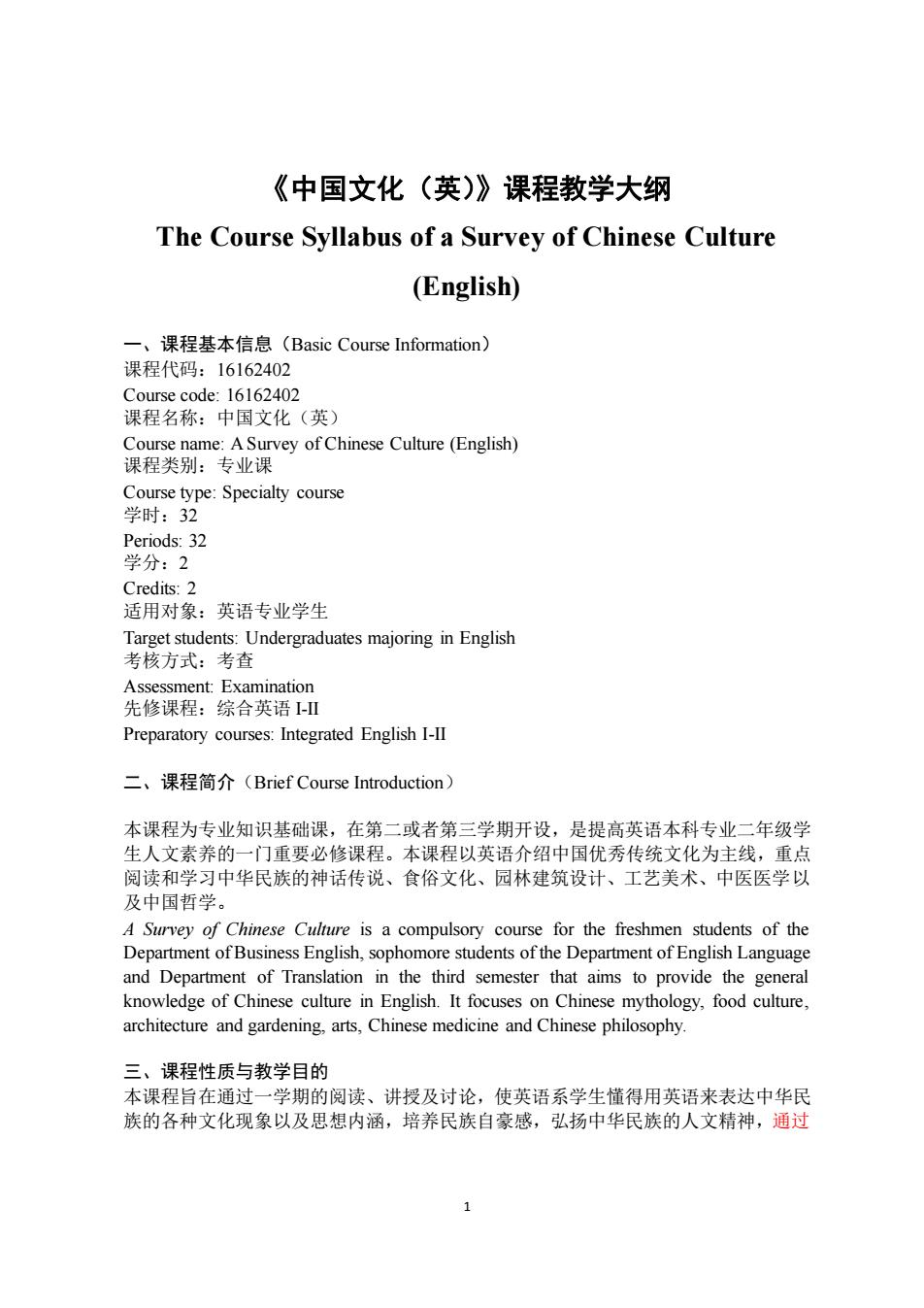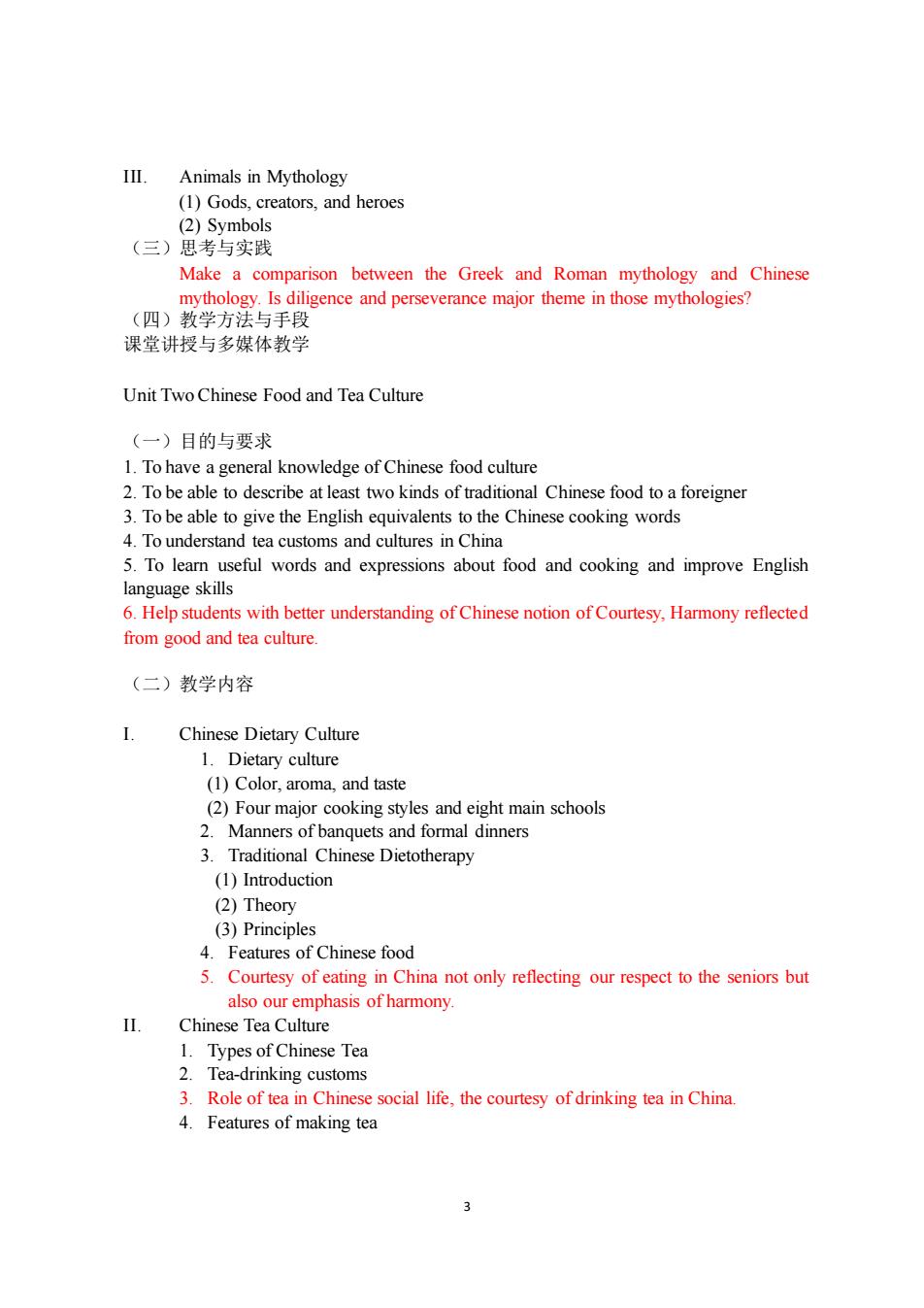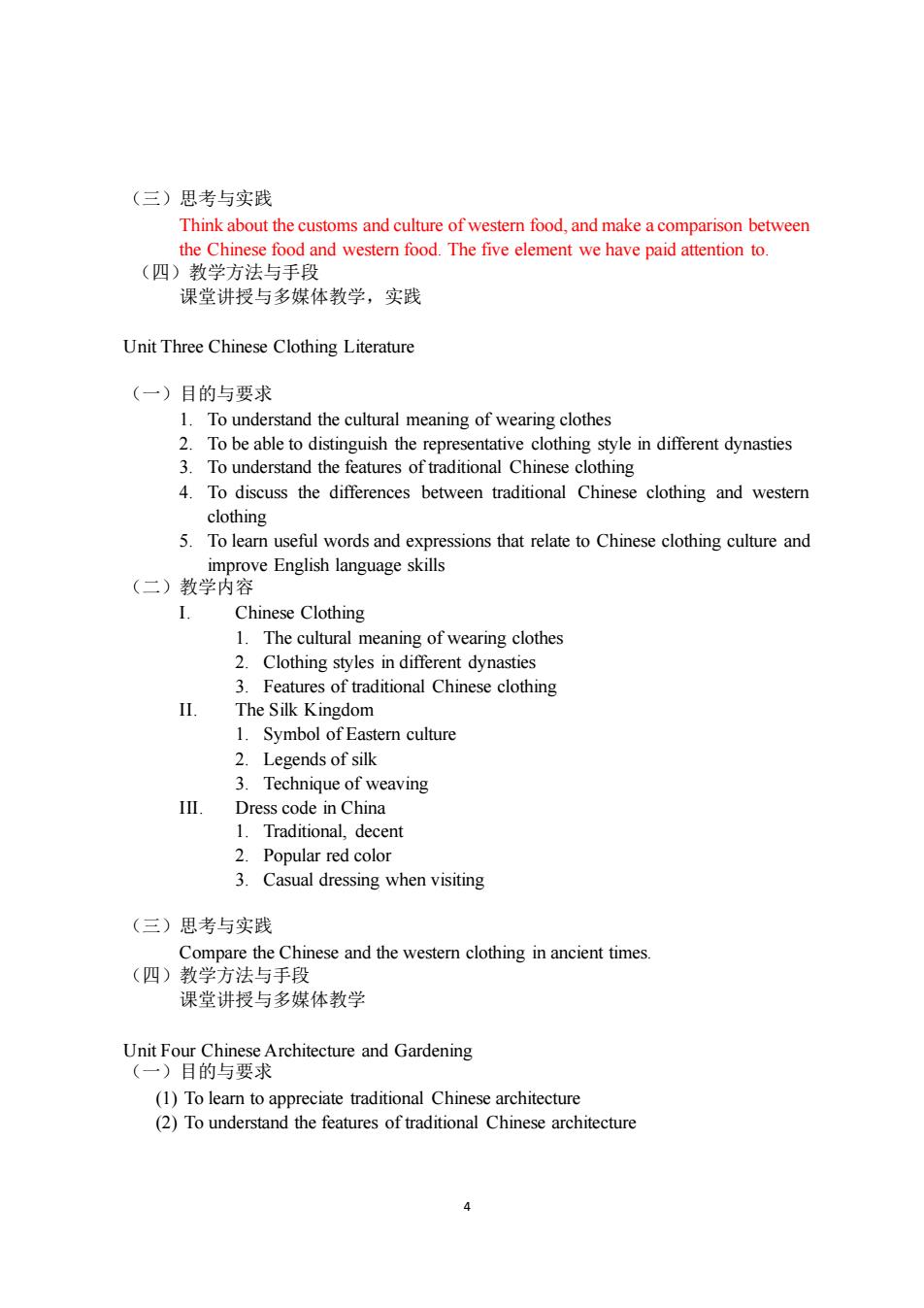
《中国文化(英)》课程教学大纲 The Course Syllabus of a Survey of Chinese Culture (English) 一、课程基本信息(Basic Course Information) 课程代码:16162402 Course name:ASurvey of Chinese Culture(English) 课程类别:专业课 Periods:32 学分:2 Credits:2 适用对象:英语专业学生 tudents:Undergraduates majoring in English Assessment:Examinatior 先修课程:综合英语Ⅱ Preparatory courses:Integrated English I-II 二、课程简介(Brief Course Introduction) 本课程为专业知识基础课,在第二或者第三学期开设,是提高英语本科专业二年级学 生人文素养的一门重要必修课程。本课程以英语介绍中国优秀传统文化为主线,重点 阅读和学习中华民族的神话传说、食俗文化、园林建筑设计、工艺美术、中医医学以 及中国哲学。 A Survey of Chinese Culture is a compulsory course for the freshmen students of the Department of Business English.sophomore students of the Department of English Language and Department of Translation in the third semester that aims to provide the general knowledge of Chinese culture in English.It focuses on Chinese mythology,food culture, architecture and gardening.arts,Chi emedicine and Chinese philo ophy 三、课程性质与教学目的 本课程旨在通过一学期的阅读、讲授及讨论,使英语系学生懂得用英语来表达中华民 族的各种文化现象以及思想内涵,培养民族自豪感,弘扬中华民族的人文精神,通过
1 《中国文化(英)》课程教学大纲 The Course Syllabus of a Survey of Chinese Culture (English) 一、课程基本信息(Basic Course Information) 课程代码:16162402 Course code: 16162402 课程名称:中国文化(英) Course name: A Survey of Chinese Culture (English) 课程类别:专业课 Course type: Specialty course 学时:32 Periods: 32 学分:2 Credits: 2 适用对象:英语专业学生 Target students: Undergraduates majoring in English 考核方式:考查 Assessment: Examination 先修课程:综合英语 I-II Preparatory courses: Integrated English I-II 二、课程简介(Brief Course Introduction) 本课程为专业知识基础课,在第二或者第三学期开设,是提高英语本科专业二年级学 生人文素养的一门重要必修课程。本课程以英语介绍中国优秀传统文化为主线,重点 阅读和学习中华民族的神话传说、食俗文化、园林建筑设计、工艺美术、中医医学以 及中国哲学。 A Survey of Chinese Culture is a compulsory course for the freshmen students of the Department of Business English, sophomore students of the Department of English Language and Department of Translation in the third semester that aims to provide the general knowledge of Chinese culture in English. It focuses on Chinese mythology, food culture, architecture and gardening, arts, Chinese medicine and Chinese philosophy. 三、课程性质与教学目的 本课程旨在通过一学期的阅读、讲授及讨论,使英语系学生懂得用英语来表达中华民 族的各种文化现象以及思想内涵,培养民族自豪感,弘扬中华民族的人文精神,通过

对中国哲学和价值观的分析和解读,培养学生的民族自豪感和爱国精神 进 一步培养 学生树立正确的社会主义价值观:通过习近平治国理政学习平台主要关注和学习中西 文化的内涵差异及英文表达的适切性、也注意引导学生关注中国传统文化,培养文化 敏成性,树立多元文化的观念 四、教学内容与要求 Unit One Chinese Mythology (一)目的与要求 1.To know and be able to tell about the historical figures in Chinese mythology ith the historical development of Chi ese mytho To understand the common themes and features of Chinese mythology 4.To learn about some differences and similarities ofthe Chinese creation story and the biblical story 5.To leam useful words and expressions that relate to Chinese mythology and improve English language skill (二)教学内容 Chinese Mythology 1.Introduction (1)The definitior of mythology (2)The classic of Mountains and Seas (3)Three religious traditions 2.Roots of Chinese mythology nasty onfucianism and Taoism (3)Buddhism 3.Common themes in Chinese Mythology (1)The creation of the world out of chaos. (2)The importance of nature (3)The re ence for estors 4.Features of Chinese Mythology (1)They sing the praises of labour and creation (2)Thev extol perseverance and self-sacrifice (3)They praise rebellion against oppression. (4)They eulogize the year ng for true love (5)They encourage good de eds and d warn against sin Jingwei determines to fill up the seas;Yugong moved the mountains To emphasize how diligent Yugong is and how determined he is,reflecting Chinese people's perseverance and self-sacrifice
2 对中国哲学和价值观的分析和解读,培养学生的民族自豪感和爱国精神,进一步培养 学生树立正确的社会主义价值观;通过习近平治国理政学习平台主要关注和学习中西 文化的内涵差异及英文表达的适切性、也注意引导学生关注中国传统文化,培养文化 敏感性,树立多元文化的观念。 四、教学内容与要求 Unit One Chinese Mythology (一)目的与要求 1. To know and be able to tell about the historical figures in Chinese mythology 2. To be familiar with the historical development of Chinese mythology 3. To understand the common themes and features of Chinese mythology 4. To learn about some differences and similarities of the Chinese creation story and the biblical story 5. To learn useful words and expressions that relate to Chinese mythology and improve English language skills (二)教学内容 I. Chinese Mythology 1. Introduction (1) The definition of mythology (2) The classic of Mountains and Seas (3) Three religious traditions 2. Roots of Chinese mythology (1) From the Xia to Zhou Dynasty (2) Confucianism and Taoism (3) Buddhism 3. Common themes in Chinese Mythology (1) The creation of the world out of chaos. (2) The importance of nature (3) The reverence for ancestors 4. Features of Chinese Mythology (1) They sing the praises of labour and creation (2) They extol perseverance and self-sacrifice. (3) They praise rebellion against oppression. (4) They eulogize the yearning for true love. (5) They encourage good deeds and warn against sin. II. Jingwei determines to fill up the seas; Yugong moved the mountains To emphasize how diligent Yugong is and how determined he is, reflecting Chinese people’s perseverance and self-sacrifice

11. Animals in Mythology (1)Gods.creators.and heroes (2)Svmbols (三)思考与实践 Make a comparison between the Greek and Roman mythology and Chinese mythology.Is diligence and perseverance major theme in those mythologies? (四)教学方法与手段 课堂讲授与多媒体教学 Unit Two Chinese Food and Tea Culture (一)目的与要求 1.To have a general knowledge of Chinese food culture 2.To be able to describe at least two kinds of traditional Chinese food to a foreigner 3.To be able to give the English equivalents to the Chinese cooking words 4.To understand tea customs and cultures in China 5.To learn useful words and expressions about food and cooking and improve english language skills 6 Help students with better understanding of Chinese notion of Courtesy.Harmony reflected from good and tea cultur (二)教学内容 Chinese Dietary Culture 1.Dietary c culture (1)Color,aroma,and taste (2)Four major cooking styles and eight main schools 2.Manners of banquets and formal dinners 3.Traditional Chinese Dietotherapy (1)Introduction (2)Theory (3)Principles 4.Features of Chinese food 5.Courtesy of eating in China not only reflecting our respect to the seniors but also our emphasis of harmony. Chinese Tea Culture 1.Types of Chinese Tea 2.Tea-drinking customs 3.Role of tea in Chinese social life,the courtesy of drinking tea in China. 4.Features of making tea
3 III. Animals in Mythology (1) Gods, creators, and heroes (2) Symbols (三)思考与实践 Make a comparison between the Greek and Roman mythology and Chinese mythology. Is diligence and perseverance major theme in those mythologies? (四)教学方法与手段 课堂讲授与多媒体教学 Unit Two Chinese Food and Tea Culture (一)目的与要求 1. To have a general knowledge of Chinese food culture 2. To be able to describe at least two kinds of traditional Chinese food to a foreigner 3. To be able to give the English equivalents to the Chinese cooking words 4. To understand tea customs and cultures in China 5. To learn useful words and expressions about food and cooking and improve English language skills 6. Help students with better understanding of Chinese notion of Courtesy, Harmony reflected from good and tea culture. (二)教学内容 I. Chinese Dietary Culture 1. Dietary culture (1) Color, aroma, and taste (2) Four major cooking styles and eight main schools 2. Manners of banquets and formal dinners 3. Traditional Chinese Dietotherapy (1) Introduction (2) Theory (3) Principles 4. Features of Chinese food 5. Courtesy of eating in China not only reflecting our respect to the seniors but also our emphasis of harmony. II. Chinese Tea Culture 1. Types of Chinese Tea 2. Tea-drinking customs 3. Role of tea in Chinese social life, the courtesy of drinking tea in China. 4. Features of making tea

(三)思考与实践 Think about the customs and culture of western food,and make a comparison between the Chin e food and westem food.The five element we have paid attention to (四)教学方法与手段 课堂讲授与多媒体教学,实践 Unit Three Chinese Clothing Literature (一)目的与要求 To understand the cultural meaning of wearing clothes 2.To be able to distinguish the representative clothing style in different dynasties 3.To understand the features of traditional Chinese clothing 4.To discuss the differences between traditional Chinese clothing and western 5.To leam useful words and expressions that relate to Chinese and (一)教学闲容engangge Chinese Clothing 1.The cultural meaning of wearing clothes 2 Clothing styles in different dynasties Features of traditional Chinese clothing I The Silk Kingdom 1.Symbol of Eastern culture 2.Legends of silk Technique weaving Dress code in China 1.Traditional,decent 2.Popular red color 3.Casual dressing when visiting (三)思考与实践 Compare the Chinese and the western clothing in ancient times (四)教学方法与手段 课堂讲授与多媒体教学 Architecture and Gardening (1)To learn to appreciate traditional Chinese architecture (2)To understand the features oftraditional Chinese architecture 4
4 (三)思考与实践 Think about the customs and culture of western food, and make a comparison between the Chinese food and western food. The five element we have paid attention to. (四)教学方法与手段 课堂讲授与多媒体教学,实践 Unit Three Chinese Clothing Literature (一)目的与要求 1. To understand the cultural meaning of wearing clothes 2. To be able to distinguish the representative clothing style in different dynasties 3. To understand the features of traditional Chinese clothing 4. To discuss the differences between traditional Chinese clothing and western clothing 5. To learn useful words and expressions that relate to Chinese clothing culture and improve English language skills (二)教学内容 I. Chinese Clothing 1. The cultural meaning of wearing clothes 2. Clothing styles in different dynasties 3. Features of traditional Chinese clothing II. The Silk Kingdom 1. Symbol of Eastern culture 2. Legends of silk 3. Technique of weaving III. Dress code in China 1. Traditional, decent 2. Popular red color 3. Casual dressing when visiting (三)思考与实践 Compare the Chinese and the western clothing in ancient times. (四)教学方法与手段 课堂讲授与多媒体教学 Unit Four Chinese Architecture and Gardening (一)目的与要求 (1) To learn to appreciate traditional Chinese architecture (2) To understand the features of traditional Chinese architecture

(3)To know the differences between traditional Chinese architecture and Western architecture (4)To lean useful words and expressions about architecture and gardening and improve (二)教学内容 anguage skills 1. Text A Ancient Chinese Architecture 1.Characteristics of Ancient Architectural Styles (1)emphasis on the horizontal (2)principle of balance and symmetry (3)making houses face south (4)timber framework (5)feng shui (6)symbolic roof 2.Imperial Architecture (1)palace (2)mausoleum (3)altars and ancestral temples 3.Religious Architecture (1Localization of Chinese Buddhist architecture (2)Pagoda (3)Grotto complex 4.Graceful Garden Architecture mperial gar rdens (2)Private gardens in the Souh 5.Traditional Culture Manifested in Ancient Chinese Architecture (1)Embodying the traditional ethical ideas (2)Idea of"unity of Heaven and man' (4)Emboc and blending of traditional culture with other cultures Number“g”and Stone lions 1.Number“g (1)Symbol of the supreme sovereignty of the emperor. (2)Combined with"s” 2. Chinese Stone Lions (1)representing power and prestige (2)indicating the ranks of officials (3)Buddhist symbol of nobleness and dignity (三)思考与实 Tell about the relationship between nature and traditional Chinese architecture.and 5
5 (3) To know the differences between traditional Chinese architecture and Western architecture (4) To lean useful words and expressions about architecture and gardening and improve English language skills (二)教学内容 I. Text A Ancient Chinese Architecture 1. Characteristics of Ancient Architectural Styles (1) emphasis on the horizontal (2) principle of balance and symmetry (3) making houses face south (4) timber framework (5) feng shui (6) symbolic roof 2. Imperial Architecture (1) palace (2) mausoleum (3) altars and ancestral temples 3. Religious Architecture (1) Localization of Chinese Buddhist architecture (2) Pagoda (3) Grotto complex 4. Graceful Garden Architecture (1) Imperial gardens (2) Private gardens in the South 5. Traditional Culture Manifested in Ancient Chinese Architecture (1) Embodying the traditional ethical ideas (2) Idea of “unity of Heaven and man” (3) Principle of integration of variety (4) Embodying communication and blending of traditional culture with other cultures. II. Number “9” and Stone lions 1. Number “9” (1) Symbol of the supreme sovereignty of the emperor. (2) Combined with “5” 2. Chinese Stone Lions (1) representing power and prestige (2) indicating the ranks of officials (3) Buddhist symbol of nobleness and dignity (三)思考与实践 Tell about the relationship between nature and traditional Chinese architecture, and